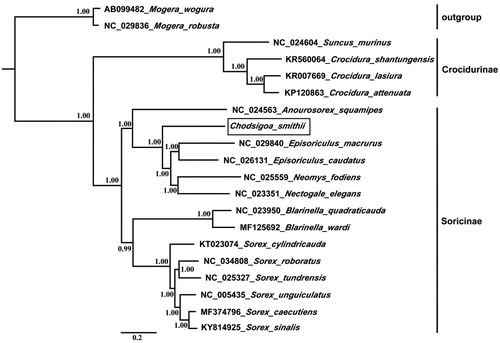Abstract
The Smith’s shrew (Chodsigoa smithii) belongs to subfamily Soricinae, which is an endemic shrew to China. In this study, we obtained the complete mitochondrial genome of the C. smithii. This mitogenome is a circular molecule with 17,108 bp in length, containing 13 protein-coding genes, 22 transfer RNA genes, two ribosome RNA genes, one light strand replication origin (OL), one non-coding region, and with a base composition of 32.5% A, 29.3% T, 24.8% C, and 13.4% G. The nucleotide sequence data of 13 protein-coding genes of C. smithii and other 19 Soricomorpha species were used for phylogenetic analyses. Phylogenetic tree shows that Soricinae includes two major phylogenetic lineages. Chodsigoa smithii is located as a basal position in tribe Nectogalini.
Chodsigoa smithii belongs to subfamily Soricinae, and is an endemic shrew to China, named by Thomas (Citation1911) based on a specimen from Kangding, Sichuan Province, China. It typically occurs in montane broad-leaved forests at elevations of 900–3000 m of Southwest China (Hoffmann and Lunde Citation2008; Chen et al. Citation2017). Chodsigoa smithii used to include C. parca as subspecies (Allen Citation1923). Subsequently, based on its smaller size and different shape of rostrum (Allen Citation1923; Hoffmann Citation1985), Hoffmann (Citation1985) recognized C. parca as a distinct species. Due to continuous loss of habitats, this species was classified as Near Threatened on The IUCN Red List (www.iucnredlist.org). Here, we sequenced the whole mitogenome of C. smithii (17,108 bp; GenBank accession number: MN038168) and examined its phylogenetic position with other 19 Soricomorpha species.
The individual was captured in Mount Emei, Sichuan Province, China (Latitude: 29°32′38″N, Longitude: 103°20′0″E; H: 2360 m). The specimen was deposited at Sichuan Academy of Forestry (SNU00039). The mitogenome of Episoriculus macrurus (NC_029840) was used to design primers for polymerase chain reaction (PCR) and used as template for gene annotation.
The whole mitogenome of C. smithii is 17,108 base pairs (bp), including 13 protein-coding genes, 22 transfer RNA genes (tRNA), two ribosome RNA genes(rRNA), one light strand replication origin (OL), and one non-coding region(D-Loop). The entire base composition is as follows: 32.5% A, 29.3% T, 13.4% G, and 24.8% C, with an A + T-rich pattern of the vertebrate mitochondrial genomes. The gene order and gene content of the mitogenome of C. smithii is identical to that observed in most other Soricidae (Chen et al. Citation2015; Kim et al. Citation2017; Wang et al. Citation2018).
In order to explore the evolution of subfamily Soricinae, we used 13 protein-coding genes data of mitogenome in C. smithii and other 19 Soricomorpha species for the phylogenetic analysis, Mogera wogura and Mogera robusta were used as outgroups. We used BEASTv1.7 (Drummond et al. Citation2012) for Bayesian phylogenetic reconstructions, and the best-fit GTR + I + G model of DNA substitution was selected using Akaike Information Criterion (AIC) test in JModelTest 2 (Darriba et al. Citation2012). The phylogenetic tree is shown in , which shows that Soricinae include two distinct phylogenetic lineages (BPP = 1.00). First lineage is containing six species from tribe Nectogalini and Anourosoricini. The second lineage is containing eight species from tribe Blarinellini and Soricini. C. smithii is located as a basal position in tribe Nectogalini.
Figure 1. Phylogenetic tree derived from 13 protein-coding gene sequences using BI analysis. Numbers by the nodes indicate Bayesian posterior probabilities.

We expect the study may be useful for phylogenetic and evolution studies of Soricinae, facilitate further investigation of the molecular evolution of genus Chodsigoa, and contribute to the conservation of this species.
Disclosure statement
The authors report no conflicts of interest. The authors alone are responsible for the content and writing of the paper.
Additional information
Funding
References
- Allen GM. 1923. New Chinese insectivore; no. 100. New York: American Museum of Natural History; p. 1–11.
- Chen ZZ, He K, Huang C, Wan T, Lin LK, Liu SY, Jiang XL. 2017. Integrative systematic analyses of the genus Chodsigoa (Mammalia: Eulipotyphla: Soricidae), with descriptions of new species. Zool J Linn Soc. 180:694–713.
- Chen SD, Tu FY, Zhang XY, Li W, Chen GY, Zong H, Wang Q. 2015. The complete mitogenome of Stripe-Backed Shrew, Sorex cylindricauda (Soricidae). Mitochondrial DNA. 26:477–478.
- Darriba D, Taboada GL, Doallo R, Posada D. 2012. JModelTest 2: more models, new heuristics and parallel computing. Nat Methods. 9:772.
- Drummond AJ, Suchard MA, Xie D, Rambaut A. 2012. Bayesian phylogenetics with BEAUti and the BEAST 1.7. Mol Biol Evol. 29:1969–1973.
- Hoffmann RS. 1985. A review of the genus Soriculus (Mammalia: Insectivora). J Bombay Nat Hist Soc. 82:459–481.
- Hoffmann RS, Lunde D. 2008. Soricomorpha. In: Smith AT, Xie Y, editors. A guide to the mammals of China. New Jersey: Princeton University Press, p. 240–241.
- Kim T-W, Kim Y-K, Oh D-J, Park J-H, Kim D, Adhikari P, Kim G, Park S-M, Lee J-W, Jung Y-H, et al. 2017. Complete mitochondrial genome of the Ussuri white-toothed Shrew Crocidura lasiura (Insectivora, Soricidae). Mitochondrial DNA A DNA Mapp Seq Anal. 28:216–217.
- Thomas O. 1911. Mammals collected in the provinces of Kan-su and Sze-chwan, western China, by Mr. Malcolm Anderson, for the Duke of Bedford’s exploration of Eastern Asia. Abstracts Proc Zool Soc London. 90:3–5.
- Wang XM, Li FJ, Zhang Q, Jiang HJ, Chen SD, Liu SY. 2018. The complete mitochondrial genome of Chinese shrew, Sorex sinalis (Soricidae). Conserv Genetics Resour. 10:229–231.
